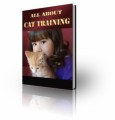Salespage Snapshot:

Table Of Contents
Foreword
Chapter 1: Cat Care Basics
Chapter 2: Visiting The Vet
Chapter 3: What You Need To Know About Vaccinations
Chapter 4: Provide The Correct Food
Chapter 5: Provide The Correct Grooming
Chapter 6: Provide The Correct Toys And Affection
Chapter 7: The Downfall Of Not training Your Cat
Wrapping Up
Sample Content Preview
Chapter 2: Visiting The Vet
Synopsis
Most animals have a natural aversion to visiting the vet, as this is usually done under unpleasant circumstances. However, as this is a necessary part of the cat’s life, some measures should be taken to make this as easy as possible for both the owner and the cat.
Keeping Them Healthy
First, the main mode of transporting the cat is the pet carrier. Measures should be taken to try and get the cat to refrain from associating this with only visits to the vet. This is because the prospect of visiting the vet is never an enjoyable one in the cat’s mind. Therefore, taking the cat out in the pet carrier for less stressful reasons will help to confuse the cat sufficiently, so that it does not associate the carrier with the vet visits.
Cats often find the carrier confining, which leads to their natural dislike and aversion towards it. Adding a favorite toy in with the cat may help to eliminate some of the stress the cat undergoes while being confined to such as small place. Placing a cloth over the carrier when in transit will also help to reassure the cat and calm it down as the darkness will give it some sense of quiet and perhaps even encourage a nap.
Taking the trouble to find a good and caring vet that is inclined to make the animal feel comfortable before actually starting the examination session is also another thing to consider when it comes getting the cat calm and accepting. If the cat is comfortable, then it is less likely to squirm and create a fuss. This will also be less stressful for both the owner and the cat. Some vets keep treats handy to try and get the cat to calm down and be more settled during the visit.
Chapter 3: What You Need To Know About Vaccinations
Synopsis
Although vaccinations are often a feared necessity, there are still a lot of problems that are usually associated with getting an animal to conform and accept this as important and unavoidable. However, the owner should be steadfast in getting all the required vaccinations for the pet cat as it will help to keep the cat in better health conditions.
Important Facts
Vaccinations are usually administered to provide an animal with the necessary help to keep their body safe from any outside invasion of organisms that will cause the cat to be sick. The cat’s immune system should be well guarded against all negative foreign intrusions, hence the necessity of the vaccinations. With the vaccinations, the cat’s immune system is able to withstand any onslaught from negative intrusion that may cause the cat’s health to deteriorate.
Cat’s that are not house bound are usually at higher risk of being exposed to disease causing organisms and thus the consequences of infection are always present. There is also the possibility of such conditions eventually affecting the owner of the cat and those around. One particular alarming disease which the owner can be exposed to is rabies, thus the need for vaccinations.
The following are some of the more popularly recommended vaccines for cats:
• Feline pan leukopenia virus vaccine – this vaccination is meant to keep the cat from contracting a highly infectious disease which can lie dormant before is actually causes fatal reactions.
• Feline claicivirus/herpes virus vaccine – this is meant to treat upper respiratory tract diseases which are prevalent in cats, which most cats are never completely free of but the vaccination helps to keep in under control.
• Rabies virus vaccine – in most countries, it is now mandatory to ensure the cat is inoculated with this as this disease is not only a threat to the cat but also to humans.
Chapter 4: Provide The Correct Food
Synopsis
Choosing food for the pet cat is not about simply providing it with the types of food it enjoys eating. These types of food are is often not nutritious or well balanced. Therefore, there is a need to ensure all the various elements are present in the cat diet to ensure optimal health conditions for the cat.
Provide Proper Nutrition
There is really no need to know a lot about cat foods and diets, as the owner would only need to know a few facts, mainly based on the cat’s statistics, to make an informed decision on the types of foods required. These facts should include the age of the cat, its size, the lifestyle and history of the cat and its breed type. All these would be a good starting point for the owner to make an informed decision on what types of foods are suitable for their pet cat.
As some cat foods are designed to fit into specific categories such as the age of the cat, its nutritional needs and its probable eating capabilities, the owner will be less challenged in making the most appropriate choice. There is a variety of choices for the cat which include dry and wet foods. Either a combination of the two or just one type would be sufficient for the cat as it usually covers a whole spectrum of vitamins and minerals that the cat would need for optimal health.
As budget is probably the main dictating factor when it comes to purchasing the most appropriate foods for the cat, most brands will suffice. However, if cost is not an issue, then making the effort to purchase premium or natural cat food products would be the ideal option, as the quality of such products would be far better than the regular ones on the shelf.
Other Details- 1 Article (DOC)
- 1 Ebook (DOCX, PDF), 20 Pages
- 1 Lead Magnet Report (DOC, PDF), 10 Pages
- 1 Autoresponder Email Messages (TXT)
- 1 Salespage (HTML)
- Ecover (JPG)
- File Size: 25,140 KB













